Abstract
Inhibition of protein kinase C (PKC) is discussed as a new approach for overcoming multidrug resistance (MDR) in cancer chemotherapy. For evaluation of this concept we applied the bisindolylmaleimide GF 109203X, which shows a highly selective inhibition of PKC isozymes alpha, beta 1, beta 2, gamma, delta and epsilon in vitro. The efficacy of this compound in modulation of MDR was examined using several P-glycoprotein (P-gp)-overexpressing cell lines including a MDR1-transfected HeLa clone, and was compared with the activities of dexniguldipine-HCI (DNIG) and dexverapamil-HC1 (DVER), both of which essentially act via binding to P-gp. As PKC alpha has been suggested to play a major role in P-gp-mediated MDR, cell lines exhibiting different expression levels of this PKC isozyme were chosen. On crude PKC preparations or in a cellular assay using a cfos(-711)CAT-transfected NIH 3T3 clone, the inhibitory qualities of the bisindolylmaleimide at submicromolar concentrations were demonstrated. At up 1 microM final concentrations of the PKC inhibitor GF 109203X, a concentration at which many PKC isozymes should be blocked substantially, no cytotoxic or MDR-reversing effects whatsoever were seen, as monitored by 72 h tetrazolium-based colorimetric MTT assays or a 90 min rhodamine 123 accumulation assay. Moreover, depletion of PKC alpha by phorbol ester in HeLa-MDR1 transfectants had no influence on rhodamine 123 accumulation after 24 or 48 h. MDR reversal activity of GF 109203X was seen at higher final drug concentrations, however. Remarkably, [3H]vinblastine-sulphate binding competition experiments using P-gp-containing crude membrane preparations demonstrated similar dose dependencies as found for MDR reversion by the three modulators, i.e. decreasing efficacy in the series dexniguldipine-HCl > dexverapamil-HCl > GF 109203X. Similar interaction with the P-gp in the micromolar concentration range was revealed by competition of GF 109203X with photoincorporation of [3H]azidopine into P-gp-containing crude membrane preparations. No significant effect of the PKC inhibitor on MDR1 expression was seen, which was examined by cDNA-PCR. Thus, the bisindolylmaleimide GF 109203X probably influences MDR mostly via direct binding to P-gp. Our work identifies the bisindolylmaleimide GF 109203X as a new type of drug interacting with P-gp directly, but does not support the concept of a major contribution of PKC to a P-gp-associated MDR, at least using the particular cellular model systems and the selective, albeit general, PKC inhibitor GF 109203X.
Full text
PDF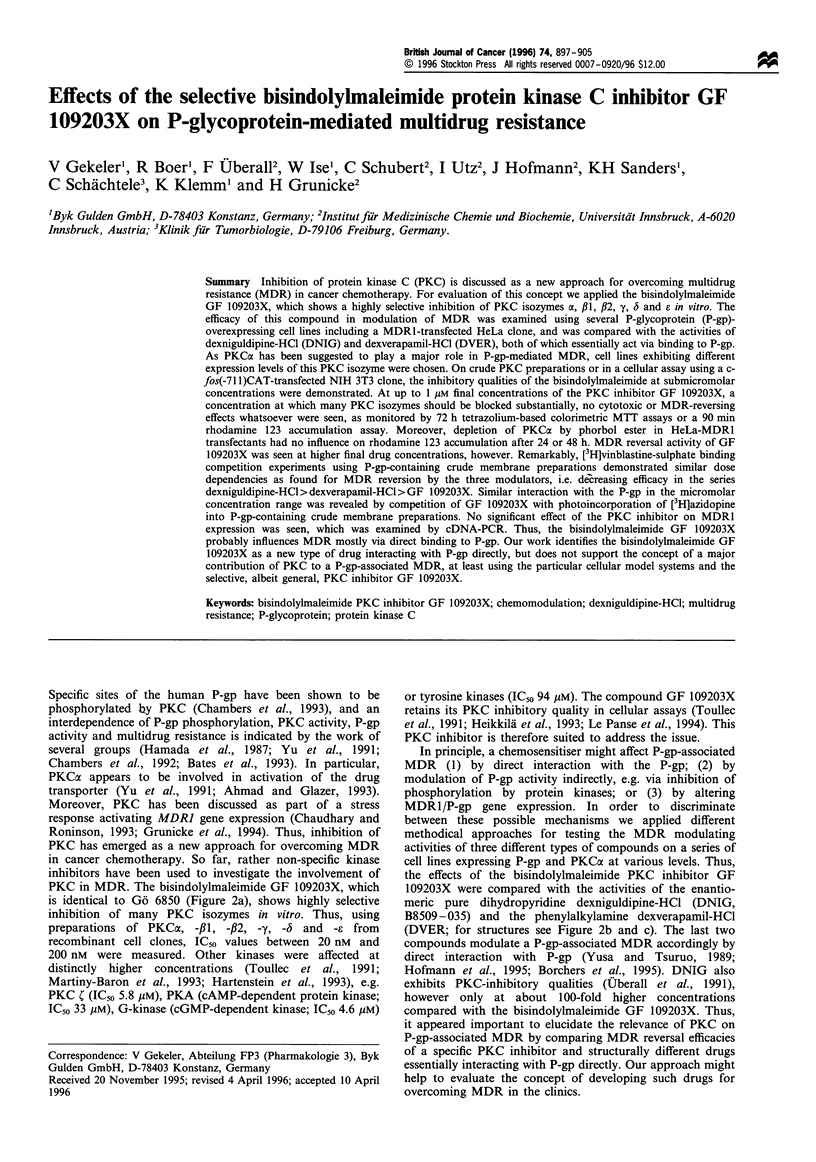
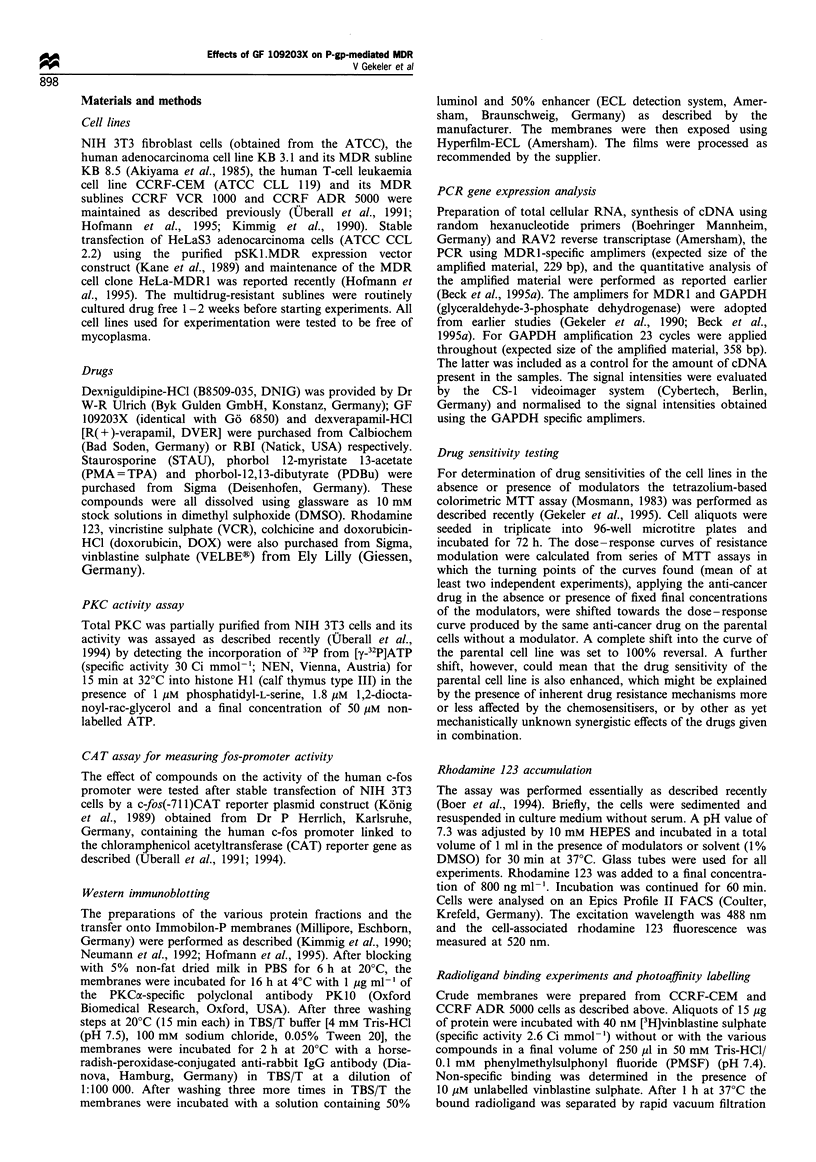
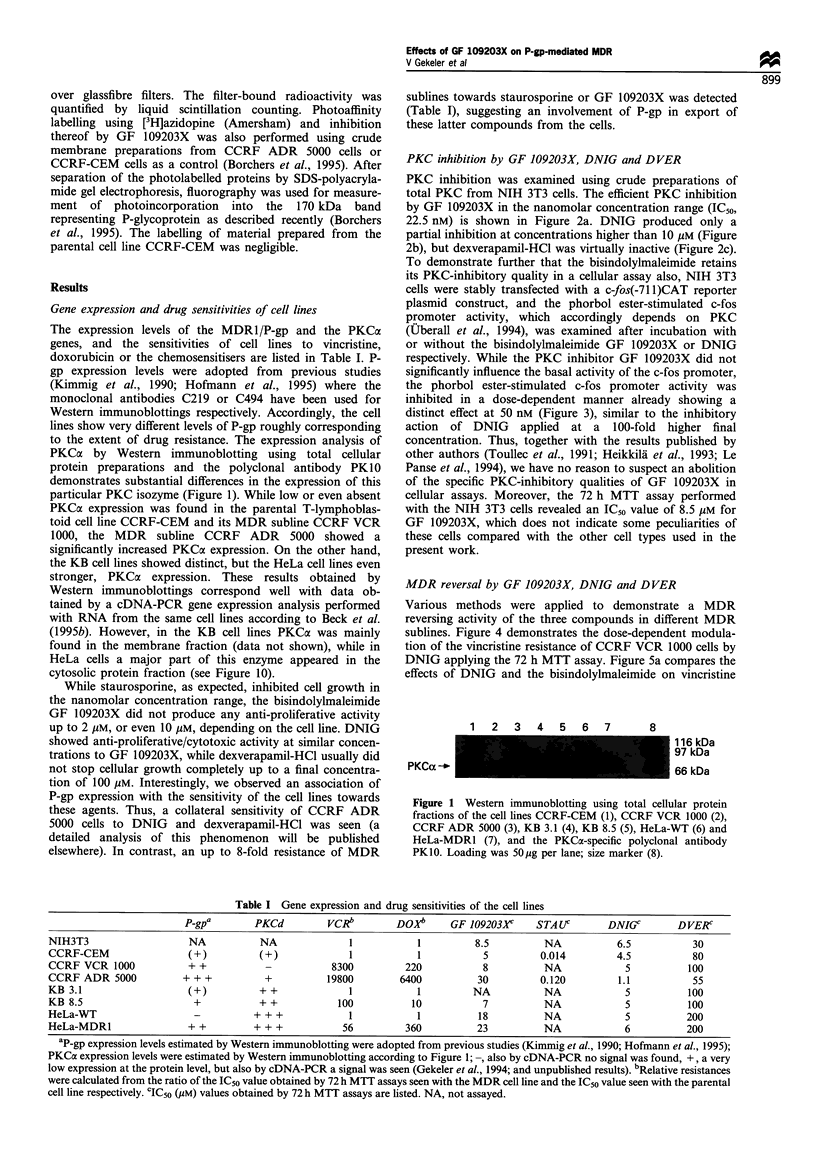
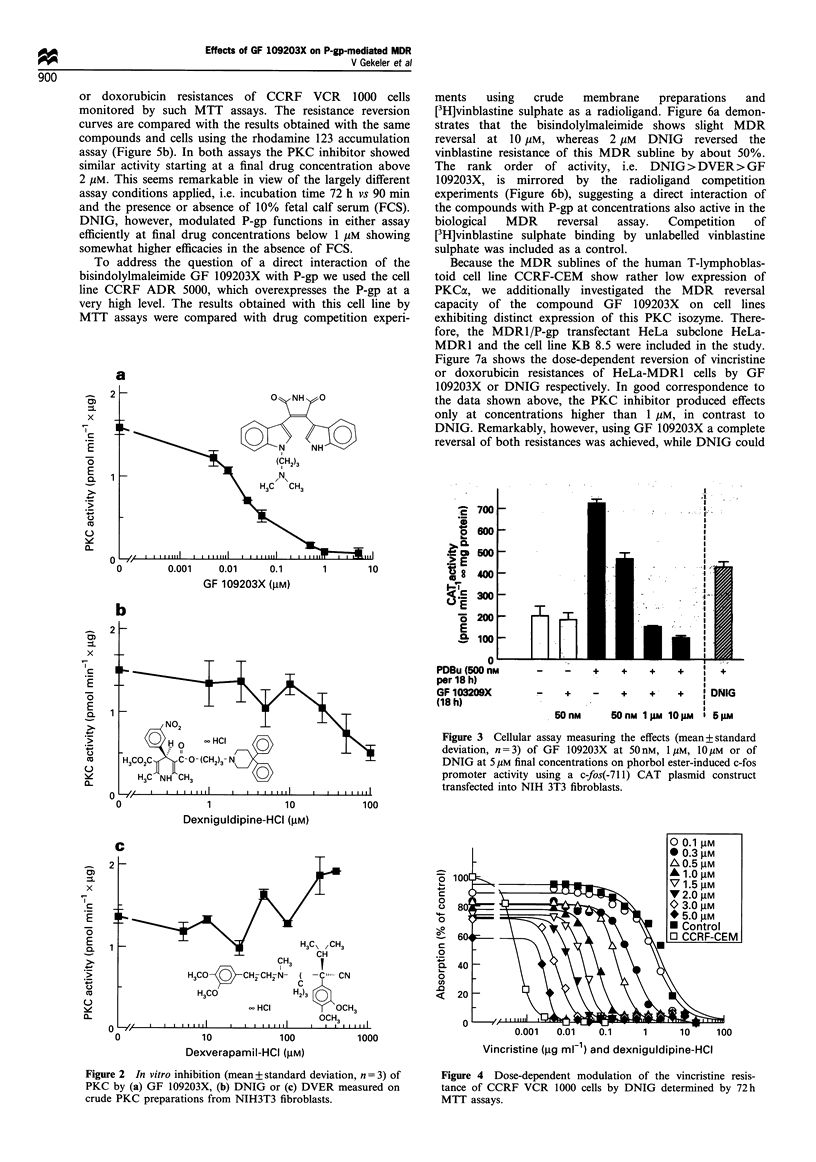
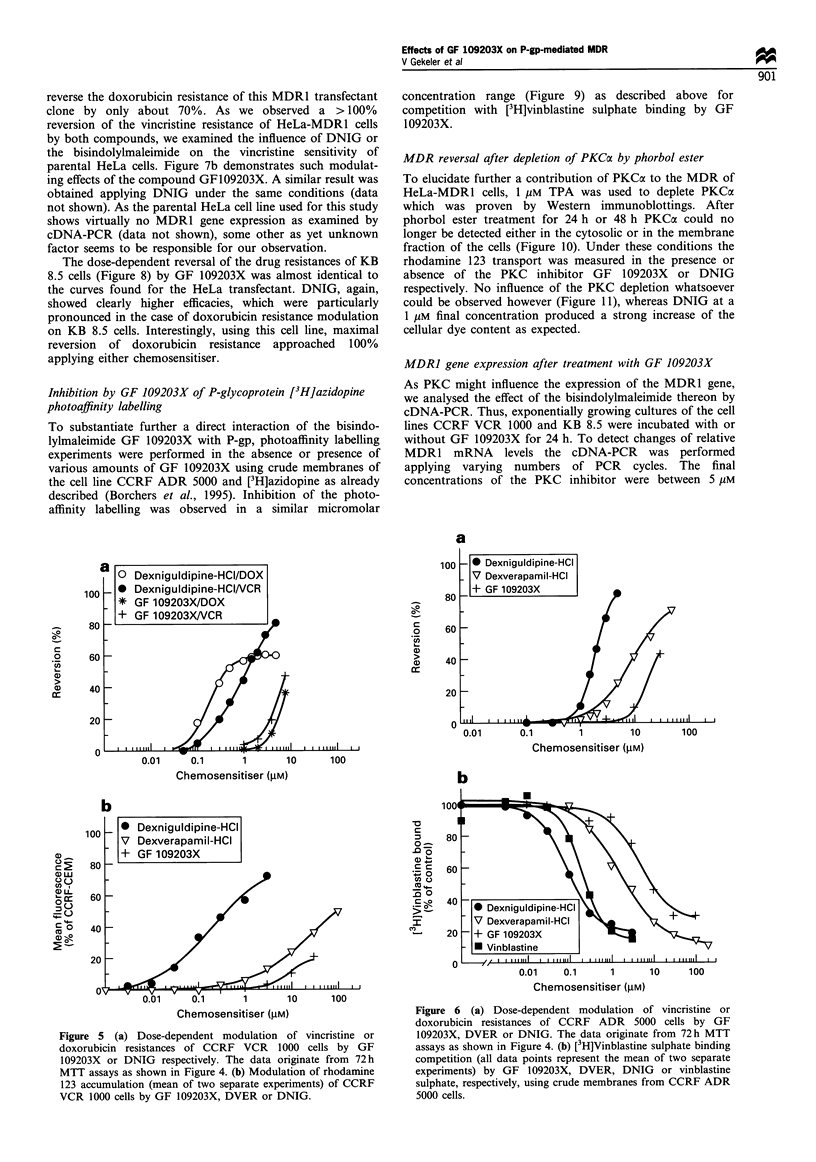
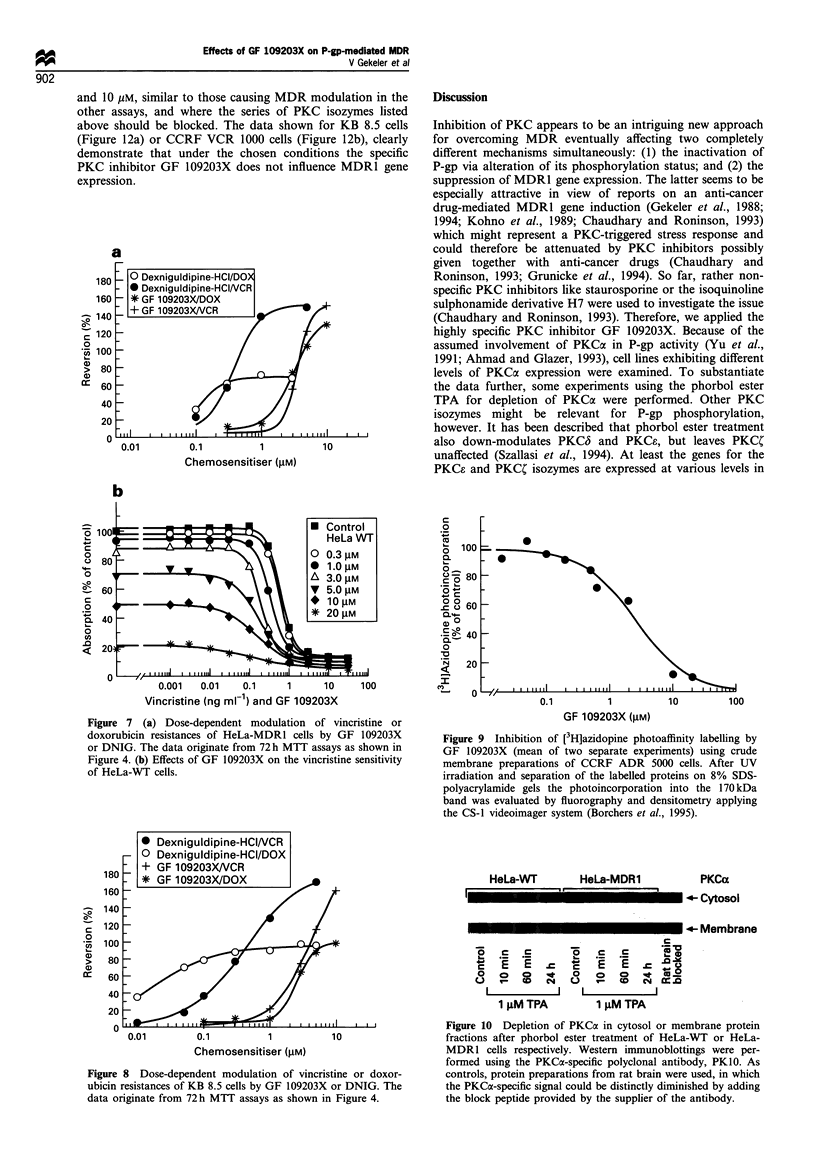

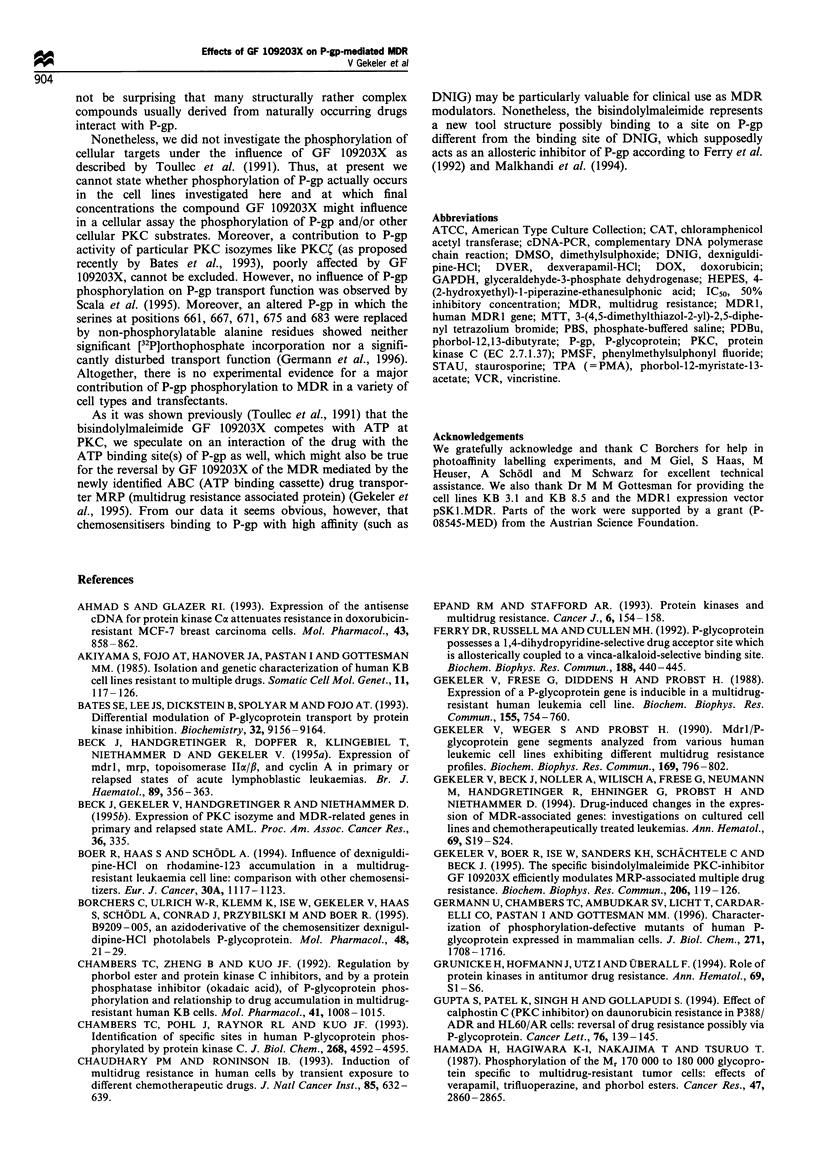
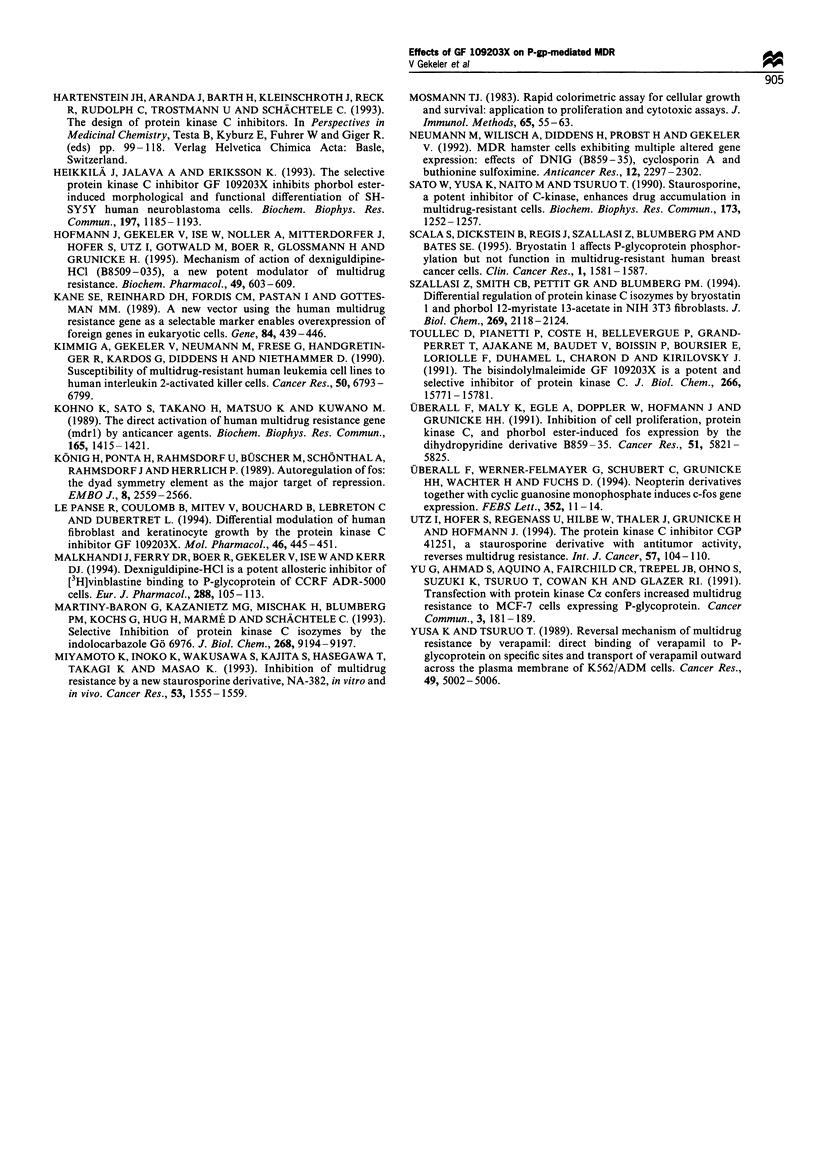
Images in this article
Selected References
These references are in PubMed. This may not be the complete list of references from this article.
- Ahmad S., Glazer R. I. Expression of the antisense cDNA for protein kinase C alpha attenuates resistance in doxorubicin-resistant MCF-7 breast carcinoma cells. Mol Pharmacol. 1993 Jun;43(6):858–862. [PubMed] [Google Scholar]
- Akiyama S., Fojo A., Hanover J. A., Pastan I., Gottesman M. M. Isolation and genetic characterization of human KB cell lines resistant to multiple drugs. Somat Cell Mol Genet. 1985 Mar;11(2):117–126. doi: 10.1007/BF01534700. [DOI] [PubMed] [Google Scholar]
- Bates S. E., Lee J. S., Dickstein B., Spolyar M., Fojo A. T. Differential modulation of P-glycoprotein transport by protein kinase inhibition. Biochemistry. 1993 Sep 7;32(35):9156–9164. doi: 10.1021/bi00086a022. [DOI] [PubMed] [Google Scholar]
- Beck J., Handgretinger R., Dopfer R., Klingebiel T., Niethammer D., Gekeler V. Expression of mdr1, mrp, topoisomerase II alpha/beta, and cyclin A in primary or relapsed states of acute lymphoblastic leukaemias. Br J Haematol. 1995 Feb;89(2):356–363. doi: 10.1111/j.1365-2141.1995.tb03312.x. [DOI] [PubMed] [Google Scholar]
- Boer R., Haas S., Schödl A. Influence of dexniguldipine-HC1 on rhodamine-123 accumulation in a multidrug-resistant leukaemia cell line: comparison with other chemosensitisers. Eur J Cancer. 1994;30A(8):1117–1123. doi: 10.1016/0959-8049(94)90469-3. [DOI] [PubMed] [Google Scholar]
- Borchers C., Ulrich W. R., Klemm K., Ise W., Gekeler V., Haas S., Schödl A., Conrad J., Przybylski M., Boer R. B9209-005, an azido derivative of the chemosensitizer dexniguldipine-HCl, photolabels P-glycoprotein. Mol Pharmacol. 1995 Jul;48(1):21–29. [PubMed] [Google Scholar]
- Chambers T. C., Pohl J., Raynor R. L., Kuo J. F. Identification of specific sites in human P-glycoprotein phosphorylated by protein kinase C. J Biol Chem. 1993 Mar 5;268(7):4592–4595. [PubMed] [Google Scholar]
- Chambers T. C., Zheng B., Kuo J. F. Regulation by phorbol ester and protein kinase C inhibitors, and by a protein phosphatase inhibitor (okadaic acid), of P-glycoprotein phosphorylation and relationship to drug accumulation in multidrug-resistant human KB cells. Mol Pharmacol. 1992 Jun;41(6):1008–1015. [PubMed] [Google Scholar]
- Chaudhary P. M., Roninson I. B. Induction of multidrug resistance in human cells by transient exposure to different chemotherapeutic drugs. J Natl Cancer Inst. 1993 Apr 21;85(8):632–639. doi: 10.1093/jnci/85.8.632. [DOI] [PubMed] [Google Scholar]
- Ferry D. R., Russell M. A., Cullen M. H. P-glycoprotein possesses a 1,4-dihydropyridine-selective drug acceptor site which is alloserically coupled to a vinca-alkaloid-selective binding site. Biochem Biophys Res Commun. 1992 Oct 15;188(1):440–445. doi: 10.1016/0006-291x(92)92404-l. [DOI] [PubMed] [Google Scholar]
- Gekeler V., Beck J., Noller A., Wilisch A., Frese G., Neumann M., Handgretinger R., Ehninger G., Probst H., Niethammer D. Drug-induced changes in the expression of MDR-associated genes: investigations on cultured cell lines and chemotherapeutically treated leukemias. Ann Hematol. 1994;69 (Suppl 1):S19–S24. doi: 10.1007/BF01757350. [DOI] [PubMed] [Google Scholar]
- Gekeler V., Boer R., Ise W., Sanders K. H., Schächtele C., Beck J. The specific bisindolylmaleimide PKC-inhibitor GF 109203X efficiently modulates MRP-associated multiple drug resistance. Biochem Biophys Res Commun. 1995 Jan 5;206(1):119–126. doi: 10.1006/bbrc.1995.1017. [DOI] [PubMed] [Google Scholar]
- Gekeler V., Frese G., Diddens H., Probst H. Expression of a P-glycoprotein gene is inducible in a multidrug-resistant human leukemia cell line. Biochem Biophys Res Commun. 1988 Sep 15;155(2):754–760. doi: 10.1016/s0006-291x(88)80559-x. [DOI] [PubMed] [Google Scholar]
- Gekeler V., Weger S., Probst H. mdr1/P-glycoprotein gene segments analyzed from various human leukemic cell lines exhibiting different multidrug resistance profiles. Biochem Biophys Res Commun. 1990 Jun 15;169(2):796–802. doi: 10.1016/0006-291x(90)90401-8. [DOI] [PubMed] [Google Scholar]
- Germann U. A., Chambers T. C., Ambudkar S. V., Licht T., Cardarelli C. O., Pastan I., Gottesman M. M. Characterization of phosphorylation-defective mutants of human P-glycoprotein expressed in mammalian cells. J Biol Chem. 1996 Jan 19;271(3):1708–1716. doi: 10.1074/jbc.271.3.1708. [DOI] [PubMed] [Google Scholar]
- Gupta S., Patel K., Singh H., Gollapudi S. Effect of Calphostin C (PKC inhibitor) on daunorubicin resistance in P388/ADR and HL60/AR cells: reversal of drug resistance possibly via P-glycoprotein. Cancer Lett. 1994 Jan 30;76(2-3):139–145. doi: 10.1016/0304-3835(94)90390-5. [DOI] [PubMed] [Google Scholar]
- Hamada H., Hagiwara K., Nakajima T., Tsuruo T. Phosphorylation of the Mr 170,000 to 180,000 glycoprotein specific to multidrug-resistant tumor cells: effects of verapamil, trifluoperazine, and phorbol esters. Cancer Res. 1987 Jun 1;47(11):2860–2865. [PubMed] [Google Scholar]
- Heikkilä J., Jalava A., Eriksson K. The selective protein kinase C inhibitor GF 109203X inhibits phorbol ester-induced morphological and functional differentiation of SH-SY5Y human neuroblastoma cells. Biochem Biophys Res Commun. 1993 Dec 30;197(3):1185–1193. doi: 10.1006/bbrc.1993.2602. [DOI] [PubMed] [Google Scholar]
- Hofmann J., Gekeler V., Ise W., Noller A., Mitterdorfer J., Hofer S., Utz I., Gotwald M., Boer R., Glossmann H. Mechanism of action of dexniguldipine-HCl (B8509-035), a new potent modulator of multidrug resistance. Biochem Pharmacol. 1995 Mar 1;49(5):603–609. doi: 10.1016/0006-2952(94)00479-6. [DOI] [PubMed] [Google Scholar]
- Kane S. E., Reinhard D. H., Fordis C. M., Pastan I., Gottesman M. M. A new vector using the human multidrug resistance gene as a selectable marker enables overexpression of foreign genes in eukaryotic cells. Gene. 1989 Dec 14;84(2):439–446. doi: 10.1016/0378-1119(89)90518-0. [DOI] [PubMed] [Google Scholar]
- Kimmig A., Gekeler V., Neumann M., Frese G., Handgretinger R., Kardos G., Diddens H., Niethammer D. Susceptibility of multidrug-resistant human leukemia cell lines to human interleukin 2-activated killer cells. Cancer Res. 1990 Nov 1;50(21):6793–6799. [PubMed] [Google Scholar]
- Kohno K., Sato S., Takano H., Matsuo K., Kuwano M. The direct activation of human multidrug resistance gene (MDR1) by anticancer agents. Biochem Biophys Res Commun. 1989 Dec 29;165(3):1415–1421. doi: 10.1016/0006-291x(89)92761-7. [DOI] [PubMed] [Google Scholar]
- König H., Ponta H., Rahmsdorf U., Büscher M., Schönthal A., Rahmsdorf H. J., Herrlich P. Autoregulation of fos: the dyad symmetry element as the major target of repression. EMBO J. 1989 Sep;8(9):2559–2566. doi: 10.1002/j.1460-2075.1989.tb08394.x. [DOI] [PMC free article] [PubMed] [Google Scholar]
- Le Panse R., Coulomb B., Mitev V., Bouchard B., Lebreton C., Dubertret L. Differential modulation of human fibroblast and keratinocyte growth by the protein kinase C inhibitor GF 109203X. Mol Pharmacol. 1994 Sep;46(3):445–451. [PubMed] [Google Scholar]
- Malkhandi J., Ferry D. R., Boer R., Gekeler V., Ise W., Kerr D. J. Dexniguldipine-HCl is a potent allosteric inhibitor of [3H]vinblastine binding to P-glycoprotein of CCRF ADR 5000 cells. Eur J Pharmacol. 1994 Dec 15;288(1):105–114. doi: 10.1016/0922-4106(94)90015-9. [DOI] [PubMed] [Google Scholar]
- Martiny-Baron G., Kazanietz M. G., Mischak H., Blumberg P. M., Kochs G., Hug H., Marmé D., Schächtele C. Selective inhibition of protein kinase C isozymes by the indolocarbazole Gö 6976. J Biol Chem. 1993 May 5;268(13):9194–9197. [PubMed] [Google Scholar]
- Miyamoto K., Inoko K., Wakusawa S., Kajita S., Hasegawa T., Takagi K., Koyama M. Inhibition of multidrug resistance by a new staurosporine derivative, NA-382, in vitro and in vivo. Cancer Res. 1993 Apr 1;53(7):1555–1559. [PubMed] [Google Scholar]
- Mosmann T. Rapid colorimetric assay for cellular growth and survival: application to proliferation and cytotoxicity assays. J Immunol Methods. 1983 Dec 16;65(1-2):55–63. doi: 10.1016/0022-1759(83)90303-4. [DOI] [PubMed] [Google Scholar]
- Neumann M., Wilisch A., Diddens H., Probst H., Gekeler V. MDR hamster cells exhibiting multiple altered gene expression: effects of dexniguldipine-HCl (B859-35), cyclosporin A and buthionine sulfoximine. Anticancer Res. 1992 Nov-Dec;12(6B):2297–2302. [PubMed] [Google Scholar]
- Sato W., Yusa K., Naito M., Tsuruo T. Staurosporine, a potent inhibitor of C-kinase, enhances drug accumulation in multidrug-resistant cells. Biochem Biophys Res Commun. 1990 Dec 31;173(3):1252–1257. doi: 10.1016/s0006-291x(05)80921-0. [DOI] [PubMed] [Google Scholar]
- Scala S., Dickstein B., Regis J., Szallasi Z., Blumberg P. M., Bates S. E. Bryostatin 1 affects P-glycoprotein phosphorylation but not function in multidrug-resistant human breast cancer cells. Clin Cancer Res. 1995 Dec;1(12):1581–1587. [PubMed] [Google Scholar]
- Szallasi Z., Smith C. B., Pettit G. R., Blumberg P. M. Differential regulation of protein kinase C isozymes by bryostatin 1 and phorbol 12-myristate 13-acetate in NIH 3T3 fibroblasts. J Biol Chem. 1994 Jan 21;269(3):2118–2124. [PubMed] [Google Scholar]
- Toullec D., Pianetti P., Coste H., Bellevergue P., Grand-Perret T., Ajakane M., Baudet V., Boissin P., Boursier E., Loriolle F. The bisindolylmaleimide GF 109203X is a potent and selective inhibitor of protein kinase C. J Biol Chem. 1991 Aug 25;266(24):15771–15781. [PubMed] [Google Scholar]
- Uberall F., Maly K., Egle A., Doppler W., Hofmann J., Grunicke H. H. Inhibition of cell proliferation, protein kinase C, and phorbol ester-induced fos expression by the dihydropyridine derivative B859-35. Cancer Res. 1991 Nov 1;51(21):5821–5825. [PubMed] [Google Scholar]
- Uberall F., Werner-Felmayer G., Schubert C., Grunicke H. H., Wachter H., Fuchs D. Neopterin derivatives together with cyclic guanosine monophosphate induce c-fos gene expression. FEBS Lett. 1994 Sep 19;352(1):11–14. doi: 10.1016/0014-5793(94)00899-x. [DOI] [PubMed] [Google Scholar]
- Utz I., Hofer S., Regenass U., Hilbe W., Thaler J., Grunicke H., Hofmann J. The protein kinase C inhibitor CGP 41251, a staurosporine derivative with antitumor activity, reverses multidrug resistance. Int J Cancer. 1994 Apr 1;57(1):104–110. doi: 10.1002/ijc.2910570119. [DOI] [PubMed] [Google Scholar]
- Yu G., Ahmad S., Aquino A., Fairchild C. R., Trepel J. B., Ohno S., Suzuki K., Tsuruo T., Cowan K. H., Glazer R. I. Transfection with protein kinase C alpha confers increased multidrug resistance to MCF-7 cells expressing P-glycoprotein. Cancer Commun. 1991 Jun;3(6):181–189. doi: 10.3727/095535491820873263. [DOI] [PubMed] [Google Scholar]
- Yusa K., Tsuruo T. Reversal mechanism of multidrug resistance by verapamil: direct binding of verapamil to P-glycoprotein on specific sites and transport of verapamil outward across the plasma membrane of K562/ADM cells. Cancer Res. 1989 Sep 15;49(18):5002–5006. [PubMed] [Google Scholar]





